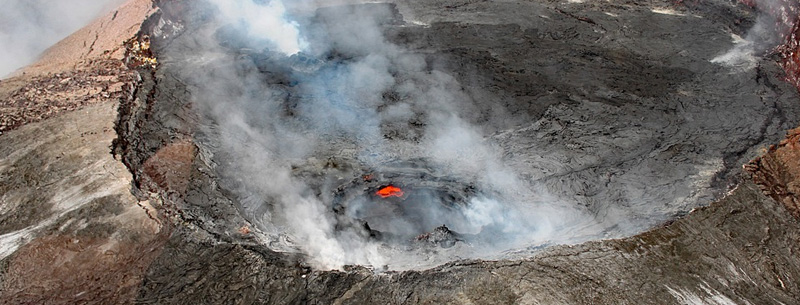Kilauea – (kē´läwā´) is a shield volcano, located in a crater 3,646 ft (1,111 m) deep. Kilauea can be found on the Big Island of Hawaii, on the southeastern slope of Mauna Loa, Hawaii Volcanoes National Park. Kilauea is one of the largest active craters in the world, has a circumference of 8 mi (13 km) and is surrounded by a wall of volcanic rock 200 to 500 ft (61—152 m) high.
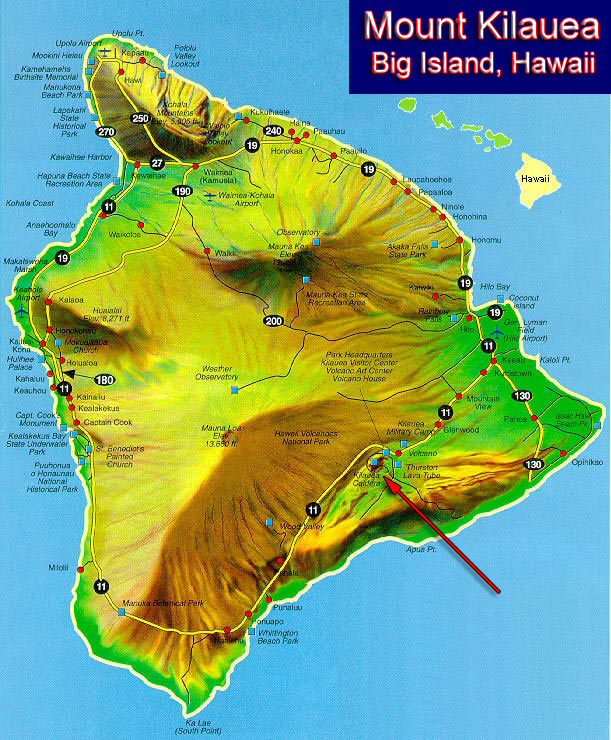
Kilauea is also the youngest volcano in Hawaii. On its floor is Halemaumau, a fiery pit. The usual level of the lake of molten lava is c.740 ft (230 m) below the pit’s rim. The oldest dated rock is about 23,000 years old and the oldest eruption of Kilauea was about 300,000-600,000 years ago. Kilauea was formed under a hot spot under the crust. So were the other volcanoes on the Big Island such as Kohala, Mauna Kea, Mauna Loa, and Hualalai. There have been 34 eruptions since 1952 and 61 eruptions total. In early 1973, an earthquake occurred that caused Kilauea to stop erupting and instead erupt near the craters Pauahi and Hi’iaka.

The latest eruption began on January 3, 1983 and ended on May 3, 2018, and is called Pu’u’O’o. Hawaii, nicknamed BIG ISLAND because of it’s 8 major volcanoes, is currently 4038 square miles (approx. 6 500 square km ) and grows around 42 acres every year thanks to all of mount Kilauea’s eruptions. Mount Kilauea is one of 5 active volcanoes in Hawaii, others are Loihi, Mauna Loa, Hualalai and Haleakala. Mount Kilauea Volcano is the home of Fire Goddess, Pele.
Facts about Mount Kilauea
- Mount Kilauea is an active shield volcano in the Hawaiian Islands, one of five shield volcanoes that together form the Island of Hawaii
- “Kilauea” means “spewing” or “much spreading,” apparently in reference to the lava flows that it erupts.
- is one of the most active volcanoes on Earth
- has its own magma-plumbing system, extending to the surface from more than 60 km deep in the earth.
- The lava is basalt, which is quite hot (2000 F) but not explosive.
- Mount Kilauea in Hawaii has erupted 62 times in 245 years. The current eruption began in January 1983 and has been going on ever since.
- A lighthouse, Kilauea Lighthouse, bears the name after the volcano.
- According to Hawaiian myths, Pele, The Goddess of Fire lives hidden in the volcano.
- If you plan to visit Hawaii Volcanoes National Park, please read carefully these safety precautions!
- Ka’u Desert, magnificent dead-like desert on the verge of Hawaiian Volcano National Park
History of Kilauea
- Kilauea Volcano began to form 300,000-600,000 years ago, active ever since
- Mount Kilauea emerged from the sea 50,000-100,000 years ago
- Oldest dated rocks 23,000 years ago
- Kilauea Caldera has formed by several incremental collapses 500-210 years ago
- 1790 – powerful explosion killed at least 80 people (mostly Hawaiian warriors and their families when they were overwhelmed by an extremely fast flow of gas and ash.
- In 1924, Kilauea exploded in a steam-driven explosion. 1 person died.
- In 1934, President Roosevelt views Kilauea crater. The 1934 Kilauea eruption was the last until 1952.
- The 1959 eruption produced some of Kilauea’s spectacular lava fountains of 20th century
- In 1960, Kapoho eruption, Kapoho Village Destroyed, Koa’e Village Damaged. The collapse of Kilauea’s summit
- In 1975, a 7.2 earthquake centered in Kilauea Volcano is the cause of a 48-foot tsunami, 2 people died.
- In 1989, Lava from Kilauea destroys Kalapana community, visitor station in Hawaii Volcanoes National Park and Kaimu Black Sand Beach
- Most recent eruption began January 3, 1983, and continuing
Shield volcano facts
Shield volcanoes are volcanoes with broad, gentle slopes and built by the eruption of fluid basalt lava (lava flows of low viscosity). Lava flows out of the volcano in all directions from a central summit vent, or group of vents, building a broad, gently sloping cone of flat, domical shape, with a profile much like that a warrior’s shield. The largest volcanoes on Earth are shield volcanoes and one of the largest known volcanoes in our solar system, Olympus Mons on Mars, is a shield volcano also.
Hawaiian shield volcanoes
The Hawaiian Islands are composed of linear chains of these volcanoes including
- Mount Kilauea (Big Island’s youngest volcano)
- Mauna Loa (largest active volcano on the planet)
- Mauna Kea (tallest volcano on the island of Hawaii)
- Hualalai
- Kohala Volcano (oldest)
Diagram of a shield volcano
- Central Vent A central vent is an opening at the Earth’s surface of a volcanic conduit of cylindrical or pipe-like form.
- Caldera The Spanish word for cauldron, a basin-shaped volcanic depression; by definition, at least a mile in diameter. Such large depressions are typically formed by the subsidence of volcanoes. Kilauea caldera(formed in 1790) is called Halemaumau.
- Magma Reservoir An underground zone of porous rock containing magma.
Pauahi Crater
Pauahi Crater is located approximately 3 miles along Chain of Craters Road and is one of it’s more impressive features. This depression is 2000 feet long (610 metres) and about 300 feet deep (90 meters) with 2300 mm annual precipitation. Pauahi Crater consists of three overlapping prehistoric pit craters. These pit craters cut across prehistoric lava flows and ash layers roughly 350-500 years old. Most of the pit craters along the East Rift Zone have complex histories which include multiple collapse events.
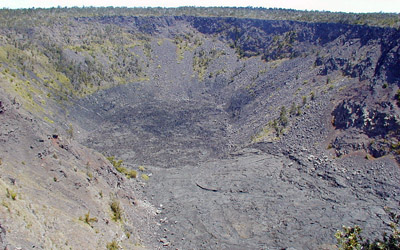
Three eruptions have occurred near Pauahi Crater in historical time: May, November 1973 and November 1979. The November 1973 eruption lasted a total of 31 days but most of the activity was during the first 10 hours of the first day. Two fissures opened in Pauahi Crater within minutes of each other, and lava began to pool in both the east and west pits of the crater. The lava not only flowed in from the fissures but also erupted from the crater itself and created a huge lava lake at the bottom of the crater. The November 1979 eruption lasted only 1 day and was preceded by a swarm of small earthquakes that started abruptly on 15 November. During the peak of the swarm, as many as 20 earthquakes per hour shook the ground beneath the Pauahi Crater area.
Pauahi Crater Trip Information
Pauahi Crater can be an interesting stop in your trip to Volcanoes National Park and Mount Kilauea Volcano. At Pauahi Crater, there is stationed a parking and a short boardwalk to a great photographic view. While you are at the end of the boardwalk enjoying the view of Pauahi Crater, turn around and note the fissure behind you. You can step off the boardwalk and walk into the fissure, as there are a number of interesting shapes. These fissures spewed lava in fountains much of which came down around the fissures themselves. The molten lava splashed on the nearby rocks creating the bizarre shapes that you can see in this area.
As with many of the other craters Pauahi Crater holds religious significance to the Hawaiians. Often you will see Ti leaf wrapped packages, fruit, leis or other gifts sitting near the edge of the crater. These are gifts to the crater and the gods and should not be disturbed.
Goddess of Fire Pele
Mount Kilauea Volcano is the home of Pele, the Hawaiian volcano goddess. Pele is a goddess of fire, lightning, dance, volcanoes and violence, a daughter of Haumea and Kane Milohai. Early Hawaiians respected and honored Pele, and made offerings to please her or calm her wrath. Every time an eruption occurs, the local people think that it is a way of Pele giving a gift.
The lava that flows out of the eruption forms new land, so the people leave offerings such as fruit, flowers, and fish to thank her for her generosity.
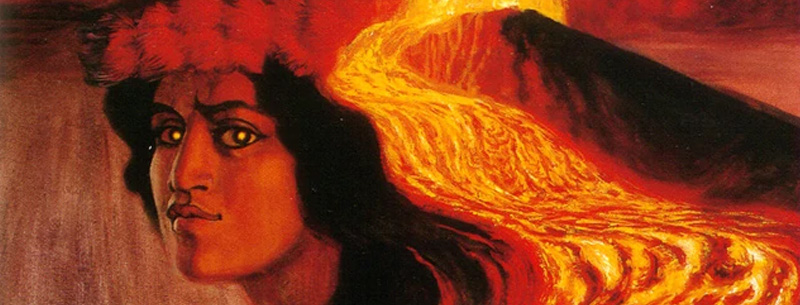
Tales tell, that Goddess Pele has a couple of talents, specifically one of them is that she can seduce any man by taking the form of a beautiful young woman. Another talent is giving more land to Hawaii, Big Island (Mount Kilauea gives contributes approximately 40 acres of new land every year).
Kilauea Lighthouse
Kilauea Lighthouse is located on the northernmost point of the main Hawaiian Islands, Kauai’s North Shore. Kilauea Point is itself a remnant of a former volcanic vent that last erupted about 500,000 years ago. Built in 1913, it was had the largest lens of it’s kind and guided ships heading to and from the Orient. The lighthouse was deactivated by the Coast Guard in 1976 and replaced with an automatic beacon. Since 1979, Kilauea Lighthouse was designated a National Historic Landmark. Kileau Point and the lighthouse became part of the Kilauea Point National Wildlife Refuge when it was established in 1985. It includes more than 200 acres of protected land and serves as the home to migratory birds such as the Pacific golden plover, seabirds such as the Laysan albatross and even Hawaii’s state bird, the Nene goose.
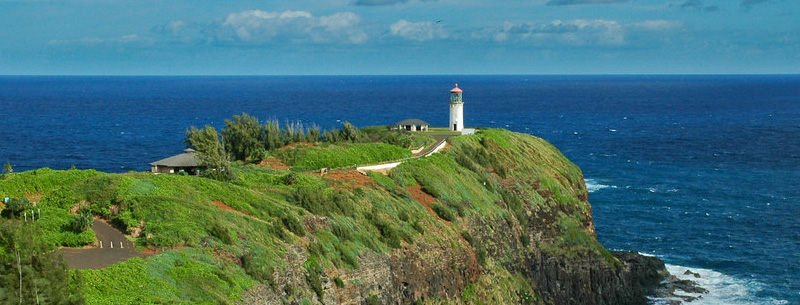
Kau Desert, Hawaii
The Ka’ū Desert is hot, scorched, quake-shaken, bubbling-up, new/dead land, made up of mostly old worn lava, some sand, and gravel.
The desert lacks any vegetation due to the consistent northeast trade winds and the rain shadow created by the island’s volcanoes. It is also spectacular that this dry and lifeless desert exists just four miles (six km) from a tropical rainforest. The Kau desert extends across the south-eastern flank of Kilauea volcano is very large and with limited access. The ocean is on one side and volcanic cliffs on the other. Hikers must prepare well in order to cross it.

How to get to Kau Desert?
You have to drive around the Kilauea Caldera on the 11-mile clockwise drive, Crater Rim Road. Also, never forget to take a look into the simmering volcano at selected overlooks. The Jaggar Museum is on the north side of the caldera. You get a good view of the caldera from Uwekahuna Bluff. The Kau Desert is a moonscape on the west side of the caldera that reminds a traveler forcefully how diverse the climate can be in only a few miles distance. Another wat –A Desert Crossing–If you follow Highway 11 counterclockwise from Kona to the Volcano, you’ll get a preview of the Kau Desert, layer upon layer of lava flows, fine ash, and fallout. As you traverse the desert, you cross the Great Crack and the Southwest Rift Zone, a major fault zone that looks like a giant groove in the earth, before you reach Kilauea Volcano. When you hike past the crater along the Halemaumau Trail, you will be surrounded by smoke and a sulfurous smell. You can make extensive hikes through the volcanic area, aided by maps available at the Kilauea Visitor Center or the Jaggar Museum.
Kau Desert and acid rain
Ka’u desert is in the rain shadow of Kilauea volcano and receives very little rain. Its barrenness also has very much to do with sulfur dioxide escaping the vents in the crater and blowing downwind. Sulfur dioxide combines with water to form sulfuric acid which falls as acid rain (30-50 inches per year).
Fossil Footprints
Nine miles from National Volcano Park and a hot and dry one-mile walk across 800-900-year-old pahoehoe lava flows are preserved footprints of Hawaiian warriors. These 200-year-old footprints were preserved in accretionary lapilli tuff from a hurricane-like blast of hot gases and ash, also called a base surge. Accretionary lapilli tuff is fine volcanic ash into forms tiny balls as a result of eruptions that involve water. The 1790 eruption, which produced this ash, was one of the most devastating explosions in Hawaiian history. The Ka’u Desert is the site where at least 80 Hawaiian warriors suffocated from volcanic ash getting into their lungs. The 1790 eruption occurred at the same time that warriors of Chief Keoua were traveling around Kilauea to Ka’u to oppose the dominant chief, Kamehameha. The footprints of these warriors are preserved in the ash.
Volcano Safety Precautions
Visiting Hawaii Volcanoes National Park safely: The things that you should have with and on you.
- Clothing
- Long pants
- Shirt with sleeves
- Boots or other sturdy closed-toed shoes
- First Aid Kit
- Falling on lava can be dangerous and can cause deep cuts.
- Accessories
- Flashlight – one for each person (in case you will be viewing the lava after 7:00 pm)
- Binoculars – to see lava and eruptions from a safe distance
- Water
- ~1 or more liters per one person
- Sun Screen
- Sun Protection Factor 15 or greater
